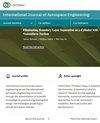基于 ACP 的空间系统:设计、开发和运行
IF 1.2
4区 工程技术
Q3 ENGINEERING, AEROSPACE
引用次数: 0
摘要
在空间技术突飞猛进和空间飞行任务日益复杂的背景下,越来越需要高效和有效的方法来应对空间系统面临的多方面挑战。传统方法往往无法为空间系统的整个生命周期提供全面支持。为应对这些挑战,本文提出了一种基于 ACP(人工系统、计算实验和并行执行)的新型并行空间系统架构,并探讨了其在空间系统设计、开发和运行中的应用。所提出的架构将人工系统与实际空间系统集成在一起,并利用计算实验生成大量样本数据。这种方法提高了人工系统模型的准确性,优化了实际系统的性能,促进了两者之间的并行发展。使用 ACP 框架实施的 Q-Sat 的设计、开发和运行过程作为案例研究,说明了并行空间系统的优势。在基于 ACP 的空间系统框架下对并行系统之间的差异进行调整后,缺失轨道补偿的精确度提高了 86.5%,24 小时预报位置误差减少了约 65 米。此外,本文还讨论了未来趋势,强调数字化、集成化和自适应空间系统的效率和可靠性将不断提高。研究结果有助于人们对并行空间系统的理解,并为该领域的进一步发展提供了宝贵的见解。本文章由计算机程序翻译,如有差异,请以英文原文为准。
ACP-Based Space Systems: Design, Development, and Operation
In the context of the rapid advancements in space technology and the increasing complexity of space missions, there is a growing need for efficient and effective approaches to tackle the multifaceted challenges faced by space systems. Traditional methods often fall short in providing comprehensive support throughout the entire life cycle of space systems. To address these challenges, this paper presents a novel parallel space system architecture based on ACP (artificial systems, computational experiments, and parallel execution) and explores its applications in the design, development, and operation of space systems. The proposed architecture integrates artificial systems with actual space systems and employs computational experiments to generate extensive sample data. This approach enhances the accuracy of the artificial systems’ model and optimizes the performance of the real systems, facilitating parallel advancements between the two. The design, development, and operation processes of Q-Sat, implemented using the ACP framework, serve as a case study to illustrate the advantages of parallel space systems. Following adjustments made to the discrepancies between parallel systems under the ACP-based space system framework, the accuracy of missing orbit compensation improved by 86.5%, and the 24-hour forecast positional error was reduced by approximately 65 m. Furthermore, this paper discusses future trends, emphasizing the increasing efficiency and reliability of digitized, integrated, and adaptive space systems. The findings contribute to the understanding of parallel space systems and provide valuable insights for further advancements in the field.
求助全文
通过发布文献求助,成功后即可免费获取论文全文。
去求助
来源期刊

International Journal of Aerospace Engineering
ENGINEERING, AEROSPACE-
CiteScore
2.70
自引率
7.10%
发文量
195
审稿时长
22 weeks
期刊介绍:
International Journal of Aerospace Engineering aims to serve the international aerospace engineering community through dissemination of scientific knowledge on practical engineering and design methodologies pertaining to aircraft and space vehicles.
Original unpublished manuscripts are solicited on all areas of aerospace engineering including but not limited to:
-Mechanics of materials and structures-
Aerodynamics and fluid mechanics-
Dynamics and control-
Aeroacoustics-
Aeroelasticity-
Propulsion and combustion-
Avionics and systems-
Flight simulation and mechanics-
Unmanned air vehicles (UAVs).
Review articles on any of the above topics are also welcome.
 求助内容:
求助内容: 应助结果提醒方式:
应助结果提醒方式:


